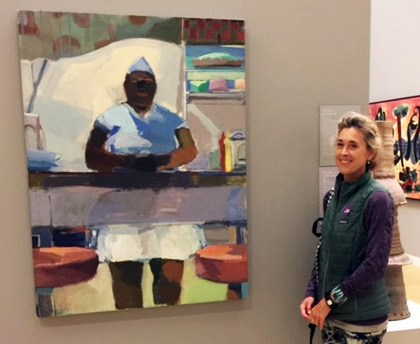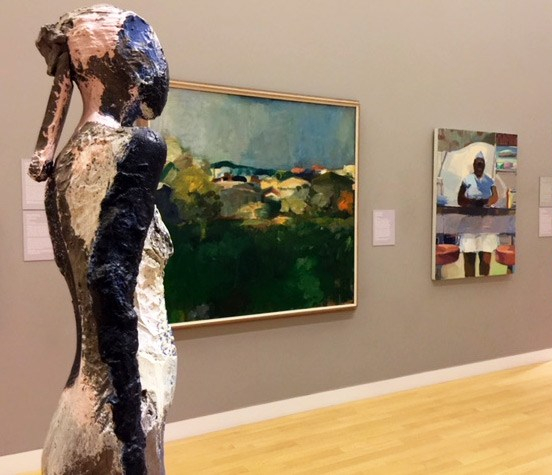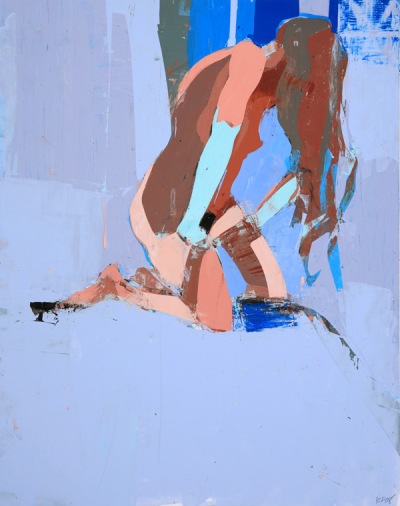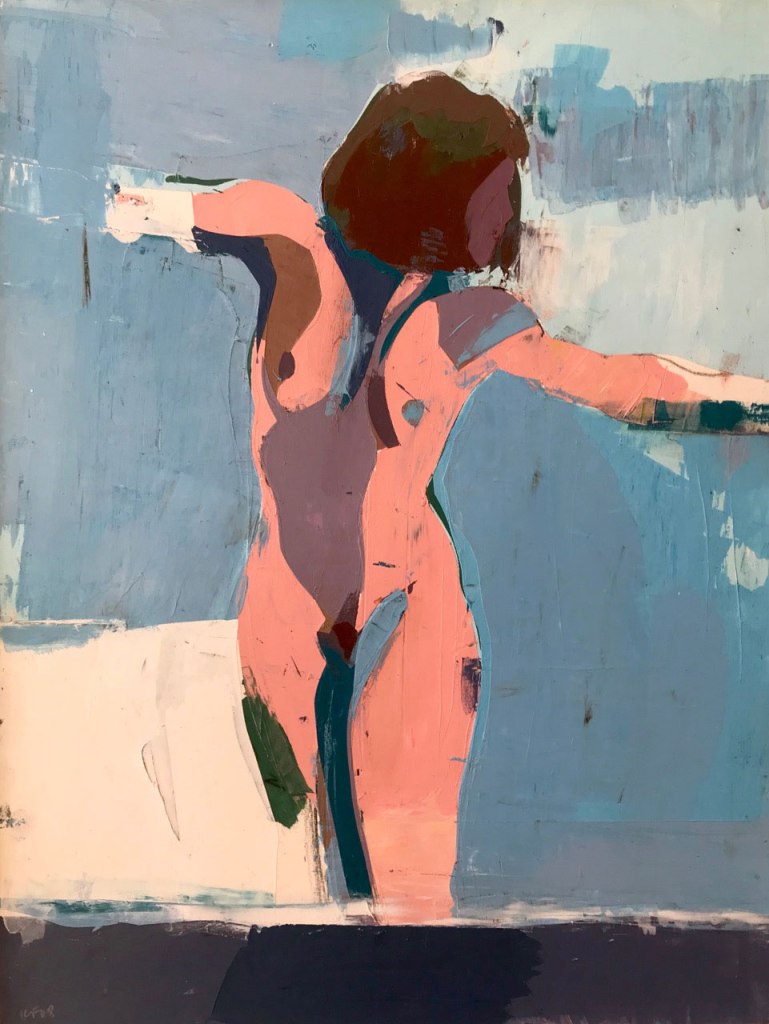Kim Frohsin at the Crocker
October 17, 2018 § Leave a comment

Kim Frohsin and “Grasshopper Pie” at the Crocker Museum.
ON A RECENT VISIT to the Crocker Museum in Sacramento, artist Kim Frohsin rounded the corner to visit the work of old friends from the Bay Area Figurative movement and found her own “Grasshopper Pie” from the 1993. It was in good company, with an Elmer Bischoff landscape and a Manuel Neri sculpture nearby.
“Since the early 1950s, when the Bay Area artists David Park, Elmer Bischoff, Richard Diebenkorn and others began to return to representational motifs, California artist have pursued abstract depictions of the human figure,” the label noted. “Few have done so with the consistency of Kim Frohsin, who finds fresh inspiration in figures both nude and clothed, indoors and out. Flat and patterned, Frohsin’s figures often seem to become one with their environment, such as this woman at a bakery counter.”

Neri, Bischoff and Frohsin at the Crocker Museum.
Artists and influences
April 24, 2017 § Leave a comment
BAY AREA ARTISTS Kim Frohsin and Sandy Ostrau discuss the Matisse/Diebenkorn exhibition, the Bay Area Figurative Movement and other influences on their work, in conversation with the Smithsonian Institution’s Paul Karlstrom.
In the studio with Kim Frohsin
February 19, 2017 § Leave a comment
Q & A | KIM FROHSIN
What is the creative process like for you?
To date it’s one in which one series or interest will somehow, in a deeply intuitive and subliminal way, lead naturally into the next work. To me, it seems like an innate flow and natural transition typifies my modus operandi over the last 29 years. There have certainly been times when my art is directly influenced by life circumstances or my reaction to those circumstances. Life on a personally intimate scale or on a large scale — for example, the death of my dog, or my reaction to 9/11. The art can serve sometimes as documentation, therapy or an emotional necessity for self-expression; the art simply emerges, life translated into imagery.
A rare gift
April 20, 2008 § Leave a comment

Kim Frohsin | Glaciale
By PETER CAMPION
Few contemporary painters manage Kim Frohsin’s sheer vivacity of color and form. And her talent extends beyond formal skill: Although she doesn’t paint overt narrative, much less illustrate her subjects, she always reveals a deep compassion for the expressive force of the body. The gestures that her figures strike are the results of intense emotions.
Frohsin’s fusion of painterly intuition and representational sympathy takes an especially surprising turn in her new paintings. “I haven’t touched a paintbrush for a year,”Frohsin explained during a recent conversation. Building on the live figure drawings that form the base of her compositions, and working with palette knives, razor blades, tape and crushed pigment, Frohsin brings new possibilities to her mark making, as well as new tones and moods.
This is what makes Kim Frohsin such a vital figure in contemporary painting, this urge to make her art from challenges, to plunge forward into the unknown even as she hones the skills she has worked for years to develop. Throughout her exploration, she has maintained her balance of formal passion and personal understanding. Hers is a rare gift, one that gives us cause for gratitude.
The dancer and the dance
July 14, 2007 § Leave a comment
By PETER CAMPION
Some artists we admire for their formal skill, and others for their quicksilver spontaneity. But there’s a third, rarer type as well. I mean the artist for whom mastery and intuition are inseparable, fused. Kim Frohsin is this kind of artist. Her work reveals a gorgeous braiding of form and process.
Drawing from the model, she captures a range of emotions as they uncoil their way through the body, seeking expression in the resulting gestures. “How can we know the dancer from the dance,” Yeats asked in one of his most famous poems. Kim Frohsin’s art brings us to that same moment of wonder.
In her series, “Two Minutes and Counting,” her project has reached a new intensity. As the title suggests, Frohsin worked on each picture within self-imposed time limits, intended to encourage immediacy. There was also an element of acrobatics involved, both for the models, who often held difficult poses, and for the artist herself. Talking with me in her studio, she described the process of making these pictures: “They became very physical. There were little wrestling matches going on.”
That feeling of resistance creates so much of the life of the series. You can see Frohsin grappling with, and through, her media. Gouache slips over into ink; watercolor and watercolor crayons trade off with dry pigment. This engagement with materials entails a spirited exchange with the tradition of art itself: Traces of Bonnard or Degas appear for moments only to be transformed beneath Frohsin’s confident hand. And there’s also a tension between the motif and the abstract identities of the pictures.
Like many of the great Bay Area painters from whom she’s learned, Frohsin wants both the representational image and its abstract, imaginative energies. She has both an uncompromising feeling for shape and color and an unstinting respect for her models as individuals, as women who inspire her.
Few of her contemporaries have her ability to capture the barest and strongest energies of bodily movement and expression, and to bring them to such compelling form. Kim Frohsin is an artist of supreme vitality.
Abstracting the figure
April 24, 2006 § Leave a comment

By PAUL J. KARLSTROM
Kim Frohsin draws with absolute authority, every line precisely what it should be. She elevates drawing to a level of expressive accomplishment that makes the individual sheets of paper that happily bear her marks fully realized works of art. In this she is among the relatively few legitimate heirs of the Bay Area Figurative School. Among her predecessors are Richard Diebenkorn, Elmer Bischoff, Nathan Oliveira and Frank Lobdell, all admired for their draughtsmanship. Among the things she and her distinguished predecessors share in common is a complete control of line and form as means to construct an unmistakably individual personal world in their art.
Figure drawing is not merely an academic exercise that, according to a peculiar recent article in The New York Times, has been picked up as a “quaint” practice by “more serious” contemporary artists in New York. In fact, the practice of drawing sessions with a live model has continued over the centuries, and it proceeds uninterrupted by stylistic changes and even major shifts in the fundamental idea of what art is, or has become. The Bay Area tradition, and Kim Frohsin’s practice, amounts to an affirmation of the insuperable centrality of drawing to the continuity and historic underpinnings of visual art.
♦
Frohsin’s drawing-based practice is traditional only in that it participates in what for centuries was understood to be the basis for depiction, and therefore comprehension, of reality. With that in mind, Kim Frohsin takes her position within a humanist tradition that seeks understanding of her place — of our place — in the world. Implicit in her work is an acknowledgment of the close relationship between representation and abstraction. This is a hallmark of modernism, an underlying concept in all figurative, or “realist,” art of significance.
Her previous series, “Provocative Poses,” was the result of what Frohsin describes as an “epiphany.” While working from the model Eden in a group session, a “little voice” told her: “Respond to the feminine in your work, as you are in your life.” The resulting drawings, in which female sexuality (model and artist) played a central role, were followed by a second and closely related group of works. With the focus remaining on the female nude figure, the artist’s chosen subject at the time, abstraction (never carried to full non-objectivity) became the thematic goal. In August 2004 another model, Reyna, pointed the direction for the subsequent step in what amounts to an evolving pictorial and psychological investigation. Abstraction, a formal and philosophical concept, was adopted as the means to deeper self-discovery. The general was, once again, deployed in the service of the personal.
♦
The idea of abstracting the figure is hardly new. But, the goal of abstracting an individual model — beyond the physical information provided by line, form, volume — is less common. And this is what Kim Frohsin has undertaken as her project in her new series. Abstraction itself has an impersonal quality, typically understood as more universal than the particularities of an individual, which are the personal and human qualities that Frohsin seeks in her quest for self-understanding. Furthermore, she seems intuitively to combine an interest in formal (stylistic) issues with a willingness to confront something far more difficult to capture: the essence of a unique, singular, human being. This is what distinguishes Frohsin’s ongoing project and, most emphatically, the abstract figure series. The particular never surrenders to the general.
To hear Frohsin talk about her models is to gain insight into their essential importance as individuals to her art — and, as I gather from our conversations, to her life as well. Reyna, Tami, Signe, Prudence, Helene, Dayla, Barbara, Lea are all individual sources of abstraction. But they are also individual women, eager to collaborate in Frohsin’s latest artistic obsession. This confidence in the artist surely comes from recognition that, for her, life drawing is not simply a classroom exercise removed from the serious business of contemporary art based on ideas. It is the fundamental basis and means for her to develop her own thinking about the intersection of art and life, providing a vocabulary for her to communicate a personal worldview that insists upon the primacy of human interaction and relationship.